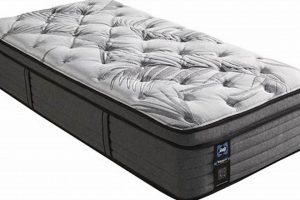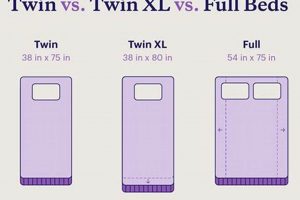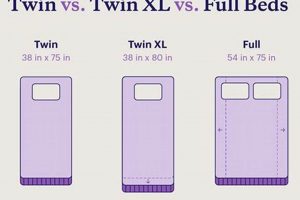A twin XL mattress is a bed size designed to be longer than a standard twin mattress. Its dimensions are typically 38 inches wide and 80 inches long. This extended length provides additional legroom, making it a suitable option for taller individuals, particularly teenagers and adults in college dormitories.
The significance of a twin XL mattress lies in its space-saving design coupled with its accommodation of taller sleepers. It offers a practical solution for bedrooms with limited square footage while ensuring a comfortable sleep experience for those who require more length than a traditional twin bed can provide. Historically, its prevalence has increased in institutional settings like college dorms to cater to a diverse student population.
Understanding the dimensions and applications of this mattress size is crucial for informed purchasing decisions. The following sections will delve into specific uses, compare it to other mattress sizes, and provide guidance on selecting appropriate bedding and frames.
Tips Regarding Twin XL Mattress Selection
The selection of a suitable twin XL mattress requires careful consideration of several factors. Ignoring these points may result in discomfort and premature replacement.
Tip 1: Prioritize Sleeping Position. Individuals who sleep on their side may benefit from a softer mattress to alleviate pressure points. Back and stomach sleepers often require firmer support to maintain spinal alignment.
Tip 2: Evaluate Foam Density. Mattresses with higher foam density typically offer improved durability and resistance to sagging. Consider the long-term cost savings associated with a more durable product.
Tip 3: Consider Coil Count and Gauge. For innerspring mattresses, a higher coil count generally indicates better support. Lower gauge coils (thicker coils) offer firmer support, while higher gauge coils provide a softer feel.
Tip 4: Assess Edge Support. Adequate edge support prevents roll-off and allows for full utilization of the mattress surface. This is particularly important for individuals who sleep close to the edge.
Tip 5: Investigate Material Composition. Be aware of potential allergens and sensitivities. Consider hypoallergenic materials or certifications such as OEKO-TEX to ensure minimal chemical emissions.
Tip 6: Review Trial Periods and Warranties. A sufficient trial period allows for adequate assessment of comfort and suitability. Comprehensive warranties protect against manufacturing defects and premature wear.
Tip 7: Measure Available Space. Confirm that the twin XL mattress dimensions are compatible with the intended bed frame and bedroom layout. Account for any additional furniture or obstructions.
Adhering to these recommendations facilitates a more informed and effective decision-making process when selecting a twin XL mattress. These considerations contribute to enhanced sleep quality and product longevity.
The following section will offer a comparison of twin XL mattresses to other common mattress sizes, providing further context for selecting the appropriate option.
1. Length
The length dimension is a critical component in defining a twin XL mattress. Its 80-inch length differentiates it significantly from a standard twin mattress, which measures approximately 75 inches. This 5-inch increase directly impacts the suitability of the mattress for taller individuals, providing the necessary legroom that a standard twin would lack. Without this extended length, taller sleepers may experience discomfort due to their feet extending beyond the mattress edge, disrupting sleep quality.
Consider a college dormitory scenario, where students are often assigned twin XL mattresses. These mattresses accommodate a broader range of student heights, ensuring that most individuals can sleep comfortably without their feet dangling. In this context, the 80-inch length serves a practical purpose, facilitating better rest and overall well-being. The increased length necessitates the use of specific twin XL bedding; standard twin sheets will not fit correctly, creating an ill-fitting and potentially uncomfortable sleep surface. Retailers specifically market twin XL sheets and mattress protectors to address this dimension.
In conclusion, the length of a twin XL mattress is not merely a technical specification; it fundamentally determines the mattress’s ability to provide adequate comfort for a specific user group. Overlooking this dimension during the selection process can result in purchasing an unsuitable product. The 80-inch length addresses a specific need, and awareness of this feature is crucial for informed decision-making. This specification influences the selection of compatible bedding and bed frames, solidifying its pivotal role in the overall utility and usability of the mattress.
2. Width
The width of a twin XL mattress significantly contributes to its overall functionality and suitability for specific users. Measuring 38 inches, this dimension directly impacts the sleeper’s ability to move comfortably during the night and affects its placement within various bedroom layouts.
- Single Occupancy Adequacy
The 38-inch width provides sufficient space for a single adult sleeper. While allowing for minimal sprawl, it remains adequate for those accustomed to sleeping within a defined area. This width often proves ideal in settings where space is limited, such as smaller bedrooms, dormitories, or studio apartments.
- Space Efficiency
Its narrower width, compared to larger mattress sizes, permits greater flexibility in room arrangement. A twin XL mattress can be readily positioned in layouts that would not accommodate a full or queen-sized bed, maximizing available floor space. This attribute is especially beneficial in shared living environments or where multifunctional room designs are employed.
- Limitations for Active Sleepers
The relatively restricted width can pose challenges for individuals who tend to move frequently during sleep. These active sleepers may experience a feeling of confinement or an increased likelihood of rolling off the mattress edge, potentially disrupting sleep quality. Consequently, individuals who prioritize unrestricted movement might find a wider mattress size more suitable.
- Impact on Bedding and Accessories
The 38-inch width influences the selection of compatible bedding. While standard twin XL sheet sets are readily available, the limited width may affect the choice of accessories such as bed skirts or decorative pillows, which must be appropriately scaled to avoid overwhelming the available space. The width also affects mattress protector size specifications.
Considering these aspects of the width in relation to the overall dimensions of the twin XL mattress allows for a more informed assessment of its suitability for particular contexts and individual preferences. The 38-inch dimension contributes to its space-saving design, making it an optimal solution for specific environments and user needs, even while presenting certain limitations for those requiring greater sleeping area.
3. Surface Area
The surface area of a twin XL mattress, calculated from its dimensions, directly determines the usable sleeping space available to an individual. Given the standard dimensions of 38 inches in width and 80 inches in length, the resulting surface area is approximately 3,040 square inches or 21.1 square feet. This measurement is a crucial determinant of comfort and functionality, particularly in confined spaces. A smaller surface area limits freedom of movement during sleep and may be unsuitable for individuals accustomed to a more expansive sleeping environment. For instance, in a college dorm room setting, the constrained floor space necessitates a compact mattress size; however, the surface area must still provide adequate comfort for a single occupant. Conversely, if the surface area is insufficient, restless sleepers may experience discomfort and disturbed sleep patterns.
The practical significance of understanding surface area extends to bedding selection. Sheets, mattress protectors, and blankets must correspond appropriately to the mattress’s dimensions to ensure proper fit and functionality. Inadequate surface area accommodation can lead to ill-fitting bedding, compromising both comfort and the protective qualities of mattress covers. Furthermore, the surface area directly relates to the load-bearing capacity of the mattress. Exceeding the recommended weight distribution across the surface area can accelerate wear and tear, potentially compromising the mattress’s structural integrity and shortening its lifespan. Real-world examples include cases where heavier individuals consistently use only a portion of the mattress, leading to localized sagging and decreased support.
In summary, the surface area of a twin XL mattress, defined by its dimensions, is an essential consideration when evaluating its suitability for a particular user and environment. It affects not only comfort and sleep quality but also the practicality of bedding selection and mattress longevity. Challenges arise when attempting to balance the space-saving benefits of a smaller mattress size with the need for adequate sleeping surface, particularly for individuals with specific sleeping habits or physical requirements. Considering the interplay between dimensions and surface area facilitates informed decision-making and optimizes the overall sleep experience.
4. Dorm Room Fit
The suitability of a twin XL mattress for dorm room environments is predicated on its dimensional attributes. Dorm rooms, typically characterized by limited square footage, necessitate efficient space utilization. The specific dimensions of the twin XL38 inches wide and 80 inches longdirectly address this constraint, offering a balance between individual comfort and spatial economy. This is why colleges and universities adopt this size as a standard for dorms in general.
A larger mattress, such as a full or queen, would significantly impede movement within the room and limit the placement of other essential furnishings, such as desks, dressers, and chairs. Conversely, a standard twin mattress, while narrower, may prove inadequate for taller students, compromising sleep quality. The twin XL, therefore, represents a compromise that accommodates both physical needs and spatial restrictions. Furthermore, the standardized use of the twin XL in dorms facilitates logistical efficiency. Residence halls can readily equip rooms with appropriately sized bed frames and bedding, streamlining the move-in process for students.
Consequently, the Dorm Room Fit aspect of “how big is twin xl mattress” dictates its functional value within this specific environment. The dimensions of the twin XL are not arbitrary; they are intentionally designed to address the inherent spatial limitations of dorm rooms. This purposeful design ensures that students can maximize the usability of their limited space while maintaining a reasonable level of comfort. Ignoring this aspect during dorm room outfitting would result in inefficient space utilization and potentially compromise student well-being.
5. Frame Compatibility
Frame compatibility is a critical consideration inextricably linked to the dimensions of a twin XL mattress. Ensuring that the chosen frame conforms precisely to the mattress’s specifications is paramount for both structural integrity and optimal sleep quality. Incompatibility can lead to diminished support, accelerated wear, and potential safety hazards.
- Dimensional Accuracy
The internal dimensions of a twin XL bed frame must precisely match the 38-inch by 80-inch measurements of the corresponding mattress. A frame that is either too small or too large will result in inadequate support, causing the mattress to sag or shift during use. Such misalignment compromises the mattress’s inherent support structure and accelerates its degradation.
- Slat Support Systems
The design and spacing of slats within the bed frame are crucial for distributing weight evenly across the mattress. Insufficient slat support, or excessive gaps between slats, can create pressure points and contribute to uneven wear patterns. The density and material composition of the slats directly influence their load-bearing capacity, ultimately impacting the long-term performance of the mattress.
- Platform Bed Considerations
Platform beds, which eliminate the need for a separate box spring, require a perfectly level and adequately supportive surface. Any inconsistencies in the platform’s construction can translate into uneven weight distribution, potentially compromising the mattress’s comfort and longevity. Thorough inspection of the platform’s surface is essential before placing the mattress.
- Headboard and Footboard Integration
While primarily aesthetic, the headboard and footboard design can indirectly affect frame compatibility. Some headboards and footboards are specifically designed to accommodate the precise dimensions of a twin XL mattress, preventing slippage or movement. Conversely, ill-fitting headboards or footboards can exert undue pressure on the mattress edges, accelerating wear and tear.
In summation, the success of a twin XL mattress setup hinges on achieving accurate frame compatibility. Each component of the bed frame, from its dimensional accuracy to the design of its support system, plays a pivotal role in ensuring both the mattress’s structural integrity and the sleeper’s overall comfort. Failure to prioritize frame compatibility can negate the inherent benefits of the twin XL mattress, leading to premature replacement and a compromised sleep experience. The “how big is twin xl mattress” consideration therefore, requires explicit emphasis on correctly proportioned support structures.
6. Sheet Sizes
The dimensions of a twin XL mattress necessitate correspondingly sized bed linens to ensure a proper fit and optimal comfort. Discrepancies between mattress size and sheet dimensions can lead to functional issues and compromised sleep quality. The “how big is twin xl mattress” consideration directly dictates the specific sheet sizes required.
- Fitted Sheet Dimensions
Fitted sheets designed for a twin XL mattress typically measure 39 inches in width and 80 inches in length, with a pocket depth that accommodates varying mattress thicknesses. Incorrect fitted sheet dimensions will result in either insufficient coverage, causing the sheet to slip off the mattress, or excessive material bunching, leading to discomfort and potential wear. For example, using standard twin fitted sheets on a twin XL mattress leaves a portion of the mattress exposed, compromising hygiene and comfort.
- Flat Sheet Dimensions
Flat sheets provide an additional layer of comfort and warmth. For a twin XL mattress, flat sheets generally measure around 66 inches in width and 96 inches in length. These dimensions allow for adequate draping on the sides and at the foot of the bed, ensuring sufficient coverage for the sleeper. Using a smaller flat sheet can restrict movement and diminish thermal comfort, whereas an excessively large sheet may prove cumbersome and aesthetically unappealing.
- Pillowcase Compatibility
While pillowcases are not directly related to the mattress size itself, coordinating pillowcase styles and colors with the overall bedding ensemble contributes to a cohesive aesthetic. Standard pillowcases typically measure 20 inches by 30 inches, providing ample space for most standard-sized pillows. Ensuring compatibility in terms of fabric type and color enhances the overall sleep environment.
- Material Properties and Comfort
The choice of sheet material significantly impacts comfort and sleep quality. Cotton, linen, microfiber, and bamboo are commonly used, each offering distinct properties in terms of breathability, softness, and durability. Considering the user’s preferences and sensitivities is crucial when selecting sheet materials. For instance, individuals with sensitive skin may benefit from hypoallergenic materials like bamboo or silk. The material must align with the size needs described by the “how big is twin xl mattress” requirement.
In summary, selecting appropriate sheet sizes is an integral aspect of optimizing the functionality and comfort of a twin XL mattress. Mismatched sheet dimensions can lead to practical inconveniences and a compromised sleep experience. Ensuring dimensional accuracy and material suitability contributes significantly to the overall effectiveness of the “how big is twin xl mattress” investment, emphasizing the importance of proper bedding selection. Careful attention to detail in this area translates to enhanced sleep quality and product longevity.
7. Height (thickness)
The height, or thickness, of a twin XL mattress constitutes a critical dimension within the broader consideration of “how big is twin xl mattress,” exerting a direct influence on both support and perceived comfort. While length and width define the sleeping surface area, the mattress’s height determines its capacity to conform to the sleeper’s body and provide adequate spinal alignment. A mattress that is too thin may lack sufficient cushioning, resulting in pressure points and discomfort, particularly for side sleepers or individuals with pre-existing musculoskeletal conditions. Conversely, an excessively thick mattress might elevate the sleeper to an uncomfortable height or create difficulties in getting in and out of bed, especially for individuals with mobility limitations. Real-world examples include dormitories where students may find overly thin mattresses inadequate for long-term use, leading to back pain and sleep disruption. The height, therefore, must be balanced against individual preferences, existing medical conditions, and the overall bed frame height.
Practical applications of understanding the connection between height and “how big is twin xl mattress” extend to selecting appropriate bedding and bed frames. A thicker mattress will necessitate fitted sheets with deeper pockets to ensure a secure fit, preventing the sheet from slipping off during the night. Furthermore, the height of the mattress must be considered when choosing a bed frame, particularly if the frame includes a headboard or footboard. An excessively tall mattress may obscure the headboard, while a mattress that is too short may leave an unsightly gap between the mattress and the headboard. This understanding also impacts the selection of bed risers; raising the bed’s height with risers can provide additional storage space underneath but may also make it more difficult for some individuals to get into bed. Proper assessment of the mattress height in conjunction with other dimensional aspects is thus crucial for achieving an optimal sleep environment.
In conclusion, the height, or thickness, of a twin XL mattress is an indispensable component of its overall size consideration. It directly impacts support, comfort, and compatibility with bedding and bed frames. Challenges arise in balancing the need for adequate cushioning with concerns about accessibility and aesthetic integration. A holistic approach, encompassing all dimensions of the mattress, including its height, is essential for making an informed purchasing decision and optimizing the sleep experience. Failing to consider height as an integral aspect of “how big is twin xl mattress” can undermine the benefits of selecting the appropriate length and width.
Frequently Asked Questions about Twin XL Mattress Dimensions
The following questions address common concerns regarding the specific dimensions of a twin XL mattress and their implications for various applications.
Question 1: What are the precise dimensions of a standard twin XL mattress?
A standard twin XL mattress measures 38 inches in width and 80 inches in length. These dimensions are non-negotiable for achieving optimal fit with designated bedding and bed frames.
Question 2: How does the length of a twin XL differ from a standard twin mattress?
The primary difference lies in the length. A twin XL is 5 inches longer than a standard twin, which typically measures 75 inches. This additional length accommodates taller individuals.
Question 3: Can standard twin sheets be used on a twin XL mattress?
No. Standard twin sheets are insufficient to properly fit a twin XL mattress due to the length discrepancy. Dedicated twin XL sheets are required for a secure and comfortable fit.
Question 4: Are all twin XL mattresses the same height or thickness?
No. The height, or thickness, varies among twin XL mattresses. It is crucial to consider the height when selecting fitted sheets and bed frames to ensure compatibility.
Question 5: Is a twin XL mattress suitable for couples?
A twin XL mattress is generally not suitable for couples due to its limited width. It is designed for single occupancy and does not provide adequate space for two adults to sleep comfortably.
Question 6: What type of bed frame is required for a twin XL mattress?
A bed frame specifically designed to accommodate a twin XL mattress is necessary. Standard twin frames are not compatible. Ensuring precise dimensional alignment is critical for structural integrity and support.
In summary, understanding the precise dimensions of a twin XL mattress is essential for informed purchasing decisions and optimal utilization. Ignoring these specifications can lead to discomfort and functional issues.
The subsequent section will provide guidance on selecting appropriate bedding and accessories for a twin XL mattress, ensuring compatibility and enhancing the sleep experience.
How Big is Twin XL Mattress
This exposition has meticulously detailed the dimensions and ramifications associated with a twin XL mattress. The core measurements of 38 inches by 80 inches significantly influence its applicability across diverse scenarios, from dorm room accommodation to individual sleep preferences. Understanding these dimensional constraints is paramount for ensuring compatibility with bedding, bed frames, and the physical needs of potential users.
Consideration of these factors is not merely an exercise in technical specification; it is a fundamental step towards optimizing sleep quality and maximizing the utility of a given space. Neglecting the “how big is twin xl mattress” imperative can lead to avoidable discomfort and compromised functionality. Prudent assessment of these dimensions, therefore, constitutes a critical investment in long-term well-being. Further research on specific mattress types and features is encouraged to refine individual selection processes.







